What are Retaining Wall Systems?
A retaining wall system is a network of retention walls that hold back the earth in key places and control the drainage of storm water.
This prevents topsoil from being washed away by the rain, protecting plant life and supported structures in the process. Walls also have a dramatic effect of elevating the landscape by adding vertical impact to key areas of interest and contributing architectural curb appeal throughout the entirety of the property.
Retention walls can be built in both the front and back yard.
Specific functional and aesthetic benefits can be gained by placing them near certain landscape elements.
In the front yard, they can significantly magnify the façade of the home by combining a variety of hardscape and softscape elements. Walls here can consist of two or three levels that can be used to grow low-level flowering plants. A central walkway bisecting the yard can terminate at a series of steps, and then continue to the front door of the home. This is a wonderful way to introduce guests to your home with a feeling of grand invitation.
Retaining wall systems in the back yard can be used to enhance the individual aesthetic of each zone of interest, while simultaneously reinforcing a sense of interconnectedness between individual elements. Because each wall can be built from a variety of materials, and can feature varying heights in different places, each section of the wall can be built in scale and scope to the element it supports.
In the far back reaches of a large yard, a retaining wall system can feature individual sections that rise up to stand over four feet in height. Drains are built in concealed locations that allow the water to pass through sections of the wall without carrying soil with it. This stops the property line from being literally eaten away by rainfall and winds.
Aesthetically, it also offers the opportunity to build a number of structures that can either expand the landscape or insulate it from the outside world. For homes that border on one of Houston’s many bayous, the top of a large retention wall is an excellent place to build a small courtyard patio where guests can overlook the water below. In more crowded neighborhoods, however, a wall like this is an excellent place to plant a row of shrubs, or even a tree wall, to shield the back yard from the watching eyes of curious neighbors.
Smaller retaining wall systems can also be built in the interior of the back yard. Walls can alter the grade of the land around outdoor kitchens and arbors and better protect their foundations from the cracks that routinely strike concrete when soil is eroded away from its edges. Smaller walls can be built around the patios and meandering walkways to better maintain a level surface year after year. Gardens retain their vitality better when insulated by a controlled grade with concealed drains that prevent water from washing soil away from roots.
The improved drainage that results from retaining wall systems prevents standing water from giving mosquitoes a place to breed. This keeps the landscape not only better persevered, but much more comfortable and habitable for humans and pets. The sculpted terrain these walls create also makes a back yard look much more appealing as a center of outdoor entertainment within the privacy of one’s own property.


